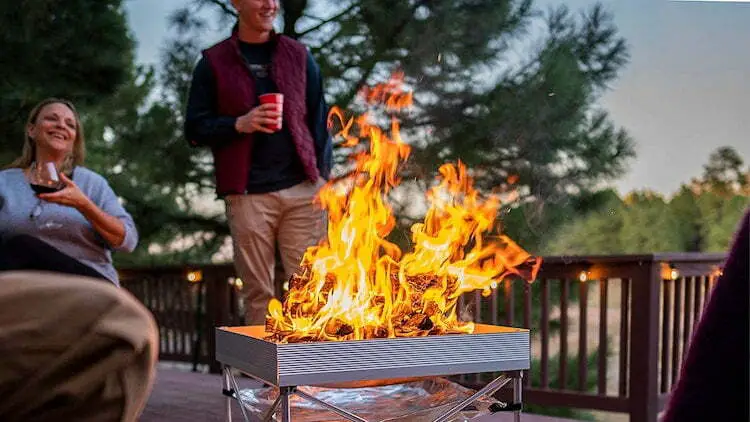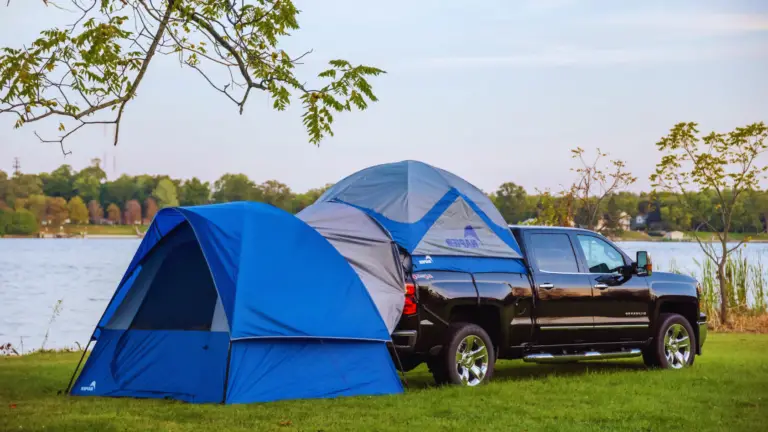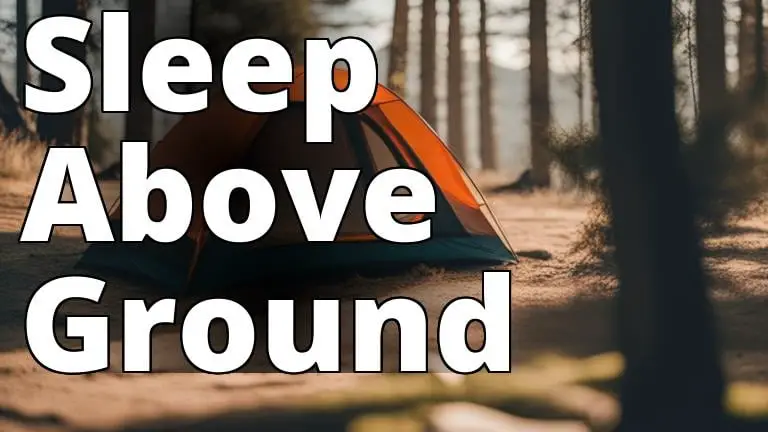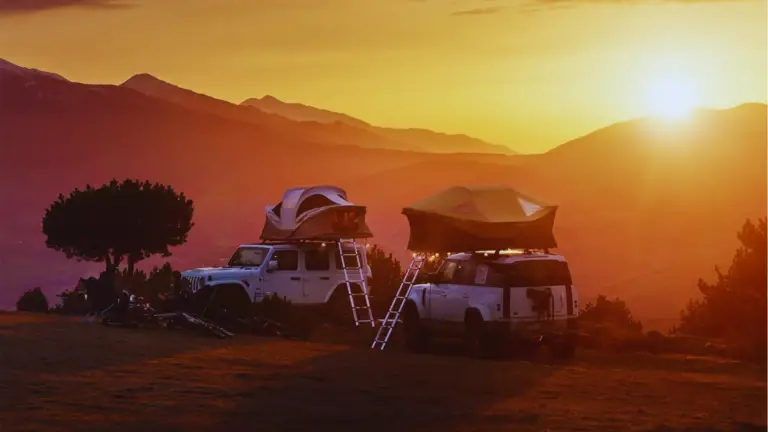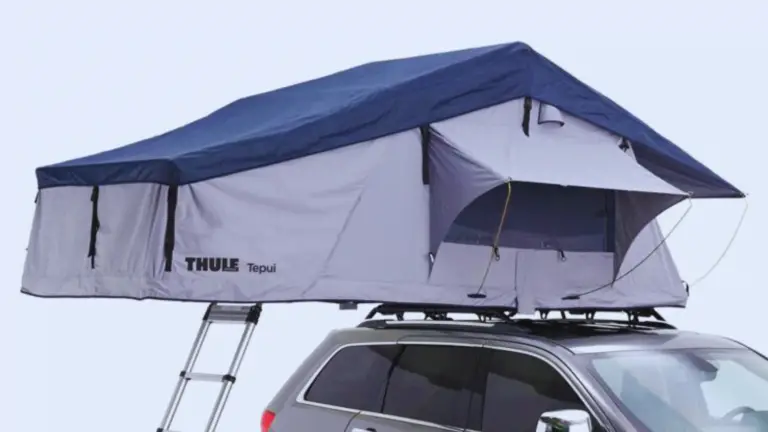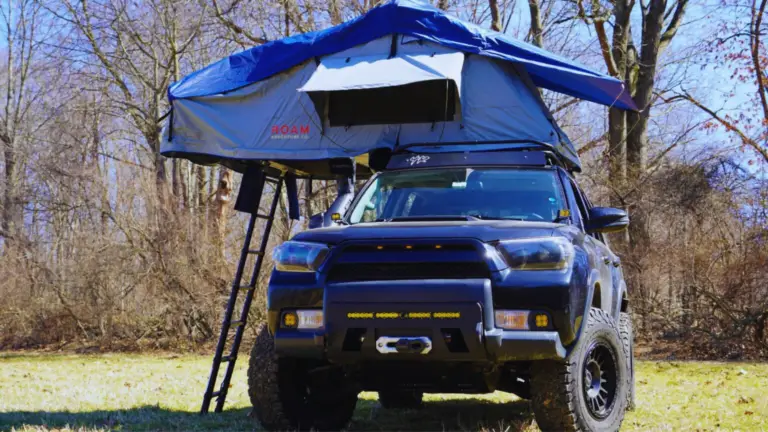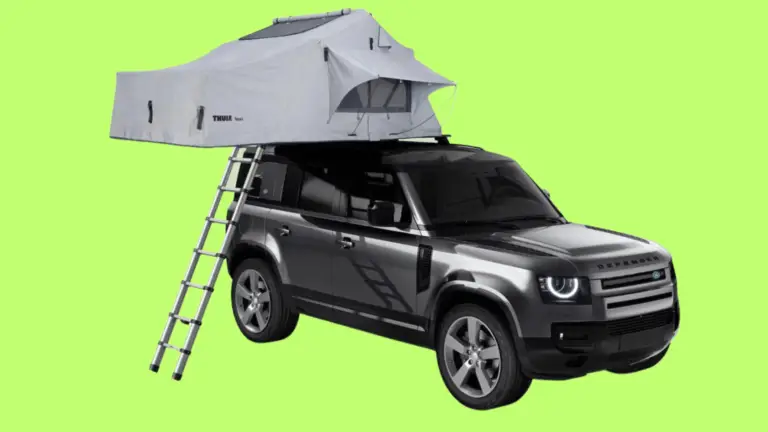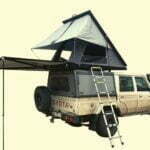Spending an evening relaxing with your pals over the campfire is a must for any camping vacation. It’s hard to beat a campfire with good company, nice beers, and sizzling steaks (or roasting marshmallows) beneath a starry sky. Like the sound of that? For such, a portable camping fire pit is essential.
A fire pit is a circular or square hole in the ground into which wood or charcoal can be thrown and allowed to catch fire. Or, to put it another way, a fire pit is the no-frills outdoorsman’s answer to a barbeque. A fire pit has multiple purposes: it can be used for cooking or just for keeping you toasty.
A frequent design feature of fire pits is legs that elevate the structure off the ground, protecting the grass and ground below from scorch scars. As damaging fires are usually forbidden on campsites and in the outdoors, this is a necessity for both settings.
Table of Contents
ToggleCamping Fire Pit: Comparison
Front Runner Box Braai
Our ratings
- Dimensions: 17.2 "L x 17.2"W x 12.2" H.
- Weight: 17.4 lb
- Fuel: Wood, charcoal
Solo Stove Ranger
Our ratings
- Dimensions: 15” L x 15" W x 12.5" H
- Weight: 15 lbs lb
- Fuel: Wood, charcoal
Fireside Outdoor Pop-Up
Our ratings
- Dimensions: 24 in. long, 24 in. wide, 15 in. tall
- Weight: 7.5 lb
- Fuel: Wood
Primus Kamoto OpenFire Large
Our ratings
- Dimensions: 18.5 in. long, 25.6 in. tall
- Weight: 15.4 lb
- Fuel: Wood, charcoal
Fireside Outdoor Trailblazer
Our ratings
- Dimensions: 12 in. long, 11 in. tall
- Weight: 3.2 lb
- Fuel: Wood, charcoal
Wolf and Grizzly Campfire Trio
Our ratings
- Dimensions: 11 in. long, 11.25 in. Wide, 3.7 in. tall
- Weight: 4.4 lb
- Fuel: Wood, charcoal
UCO Flatpack
Our ratings
- Dimensions: 7.5"D x 16"W x 7.48"H
- Weight: 3.3 pounds
- Fuel: Wood, charcoal
BioLite FirePit+
Our ratings
- Dimensions: 13"D x 27"W x 15.8"H
- Weight: 9.8 pounds
- Fuel: Wood
Heininger Portable Propane Outdoor Fire Pit
Our ratings
- Dimensions: 19.25"D x 19.25"W x 11.5"H
- Weight: 22 pounds
- Fuel: Liquefied Petroleum Gas
Outland Living 863
Our ratings
- Dimensions: 21"D x 21"W x 9.25"H
- Weight: 26 pounds
- Fuel: Liquefied Petroleum Gas
Camping Fire Pit: Review
Having read this, you should have a better understanding of what features a good portable camping fire pit should have. If you’re looking for the best camping fire pit, keep reading our reviews.
1. Front Runner Box Braai

The most prevalent problem with flat-folding fire pits is that they are too fragile. Primus, who invented the flask, solved this issue by building the Kamoto Openfire Pit.
It has sturdy scissor legs made of steel. Like the Höfats Beer Box, this comes with a wire rack so it can be used as a grill, but its primary function is as a fire pit.
Fire up the wood stove or load up the coal stove. It’s also great that the Kamoto is elevated off the ground, as this ensures that it will comply with the rules of many campgrounds. Also, there is a strong foundation, which allows it to act as an ash tray of sorts to prevent the ground.
What we like
- Safely confines your fire and keeps it off the ground.
- 30-second setup.
What we don't like
- It's a touch pricey.
2. Solo Stove Ranger

Solo Stove’s Bonfire 2.0 has a removable ash pan. The ash pan adds five pounds to the overall weight, a 20% increase. The 2.0 Bonfire features a drawstring carrying case, which we appreciated. The case is a huge bag with handles, making it easy to transport and avoiding ashes from dropping out in our car, house, or wherever.
Solo Stove’s smokeless fire pit works well. The fire pit is a double-walled stainless-steel cylinder with base and top apertures. As fire heat rises, it pushes air through the inside holes and the bottom outer holes, creating secondary combustion that reduces smoke and accelerates the burn. Bonfire 2.0’s strong, smokeless flame tore through wood. We used logs faster than with an open fire. With steady airflow, the fire burned hot and rapidly, leaving minimal ash.
The 2.0 ashpan improves cleanup. Picking up the bonfire to dump it was cumbersome, and knocking out the ashes risked denting the body. We had to remove the ventilated bottom grate to clear the ash pan. You’ll want to wear gloves since the fire pit will be filthy. We may discard the pan after removing the grating. The pan is smaller than the grate, so ash will fall outside. We had to tip the burner sometimes to pour out stray ashes.
What we like
- True smokeless flames.
- The ashes are safely contained in a container with a beautiful design.
What we don't like
- Rapidly burns firewood.
3. Fireside Outdoor Pop-Up

The pop-up may be folded down to roughly the size of a standard camp chair. But bust it out, and you’ve got a framework for building a nice big blaze. Fireside Outdoor claims that a 4-square-foot stainless-steel mesh surface can support up to 125 pounds of wood, and the 3.5-inch-high walls do an excellent job of shielding the fire from the wind without limiting the expansive heat zone. Moreover, the mesh increased ventilation and decreased smoke production. The top being fully removable makes it easy to manage the fire and replenish the wood supply.
Setting up the device is not easy. The legs folded out quickly, but after that, it took some work to set up the bottom heat shield with the Velcro straps, lower each of the four walls onto the stanchions, and finally slip on the mesh. That’s a lot of pieces to keep care of, but the pop-up’s wonderful if you want to post up by a raging bonfire for a few hours (or grill up a mess of food on the extra tri-fold grate).
What we like
- The fire can be easily tended to because to the open layout.
What we don't like
- Complex set up
4. Primus Kamoto OpenFire Large

You can trust the Swedes to create a fire pit with a sleek, uncluttered aesthetic. Together, these features provide for a quick and simple assembly process: we just lifted the ends to make a sturdy X shape, placed the free leg side in the grooves, slid in the stainless-steel platform and side wind shields, and got to work lighting the fire. The wind shields performed a decent job of keeping out the cold air but were not too thick to prevent the heat from circulating. Easy cleanup is a benefit of the big ash tray, but it should be placed on a level, debris-free surface so that it doesn’t wobble and cause sparks.
In preparing the Kamoto, we slashed open a finger on one of the triangle cuts, which was our largest problem with the stainless steel. So, setup requires caution. Apart from the flesh wounds, we really liked this fire pit because of its portability, convenience of use, and large grilling surface provided by the attached grate.
What we like
- Extremely compact when folded up.
What we don't like
- Edges that cut.
5. Fireside Outdoor Trailblazer

Once we had the fire started, the Trailblazer’s high walls protected the flame from the wind, just like the pop-up above. Similar to the bigger model, this pit requires a more complicated setup than the others on our list and a fairly hard process of hooking up the heat shield on the frame. Nonetheless, it appears that the heat shield was effective. We put our palms under it and didn’t feel any heat from the fire; however, Fireside recommends keeping the shield at least 4 inches from the flame to prevent it from delaminating.
We were worried that the tri-fold grate on top would make it difficult to fuel the fire; however, the grate sits high enough that we were able to fit smaller logs through the opening. And with all that open floor area, it’s hard to imagine you’d ever need more than 45 pounds worth of fuel for your fire.
What we like
- Once assembled, it's sturdy and simple to use.
What we don't like
- Complicated construction.
6. Wolf and Grizzly Campfire Trio

It might be restrictive to think of the Campfire Trio as a fire pit. There are three components: a fire safe, a grill, and a fire pit. The Campfire Trio may be easily transported in a backpack due to its ability to be split into two compact pieces.
The name says it all: the Fire Safe is designed to keep your campfire contained. It took us fewer than two minutes to assemble the Fire Safe. It’s as easy as can be. The grilling process was only somewhat longer. You can start a fire without matches thanks to the Fire Set, which features a pair of metal bars that, when rubbed together, create sparks. The quantity and length of the sparks quite astounded us. A fire might be ignited quickly and easily with enough skill and the correct equipment.
However, the Fire Safe has a tiny 11-inch footprint, which severely restricts the size of the fire we can build and, by extension, the amount of heat we can extract from it. By squeezing together, we were able to warm our hands, and by relaxing, we warmed our feet.
Having allowed the fire to go down to embers, we grilled some burgers on the grill on the Fire Safe. The grill’s height was readily modified to ensure that the food was in the optimal cooking zone above the coals, resulting in exquisite outcomes. The Campfire Trio is a terrific piece of camping equipment that can be used as a grill, packs up little, and keeps a fire contained safely.
What we like
- Incredibly simple to set up.
What we don't like
- Its small size restricts the heat it can radiate.
7. UCO Flatpack

The Flatpack, with its sleek canvas cover, might easily be mistaken for a laptop. In its compacted form, it’s as thin as that. Though it was the smallest of the complete fire pits we tried, it was rather stable after we extended the legs. Keep in mind that the stainless steel body is so light that it can only hold 10 pounds of wood or charcoal. Also, since you can’t just pile big logs on top of a fire started with little wood, it requires constant tending. Given the size of the hole, it is preferable to maintain the weight on level ground.
The integrated grill grate is perfect for grilling up some hot dogs and burgers in the great outdoors (or at a nearby park if you live in a cramped city flat). Despite the modest size of the fire, we discovered during testing that the flatpack generated an unexpectedly large quantity of smoke. However, this fire pit has one feature that none of the others do: it can be cleaned in the dishwasher.
What we like
- Dishwasher-safe.
What we don't like
- Made a lot of smoke, apparently.
8. BioLite FirePit+

BioLite’s FirePit+ uses a lithium-ion battery, fan, Bluetooth, and smartphone to achieve smokeless combustion. We were cautious about using the FirePit+ with a battery, yet we never ran it down. We could charge it three times. The fan has four speeds—max, high, medium, and low—with a 30-hour runtime on low.
The FirePit+ is too huge for hiking due to its size, weight, and folding legs. Due to its size, we found it performed best with 2-3-inch-diameter firewood. The rectangle accommodated four 12-14-inch logs. When we utilized the FirePit+ with the fan on low or medium, we saw smoke when it was windy. With the fan on high, wisps evaporated.
Unlike other smokeless fire pits, the FirePit+ includes mesh sides. Sitting close it lets you feel the heat on your lower legs. We sensed warmer zones on both long sides of the fire pit, but less so at the short ends.
You can barbecue on the FirePit+ using the provided grate. BioLite’s free app controls fan speed and monitors battery life. We found it straightforward to set up and helpful for estimating run-time.
What we like
- Using fans may reduce the amount of smoke in a room.
- Gratch for the grill is detachable.
What we don't like
- The loudest setting on the fan is high.
9. Heininger Portable Propane Outdoor Fire Pit

The Heininger 5995 propane-powered portable outdoor fire pit is highly recommended. Hot dogs and s’mores would be delicious cooked over it. Its 58,000-watt heating output is more than adequate for use with portable fire pits. The diameter is 19 inches, and the hose is 10 feet long.
We think that a hose with a length of 10 feet and a diameter of 19 inches is perfect for use in an RV. The 19-inch diameter of the hose is just right, providing ample room without feeling claustrophobic.
The recommended minimum length of a garden hose is 10 feet, although some individuals may prefer a longer one. Look into the suggested fire pit accessories if you’re interested in trying a longer hose.
Thousands of satisfied customers and over 200 questions addressed on Amazon should sway your decision to purchase and use this fire pit.
The total mass of the propane fire pit is 22 kg. They also have lighter options, although the quality may suffer as a result.
On the high setting, it may consume a lot of propane, according to some reviews. A unit with a BTU output of 58,000 can be anticipated to achieve this. The greater the need for heat, the higher the BTUs and the amount of propane required to meet that need.
What we like
- Using fans may reduce the amount of smoke in a room.
- Gratch for the grill is detachable.
What we don't like
- The loudest setting on the fan is high.
10. Outland Living 863

Another option among the Outland propane fire pits is the Outland Living 863. It’s a tad bigger than the 893 variant. The 21-inch diameter and 58,000-BTU output remain unchanged in this variant. It’s a bit more convenient for gatherings of considerable scale due to its greater size.
More rocks may be stored in the bigger container. Greater rocks equal more heat radiation. Having this knowledge is crucial if you plan on using portable propane fire pits for heating purposes.
What we like
- Non-smoky and clean-burning.
- Lightweight and simple to transport.
What we don't like
- Available with a protective case for portability at a cost.

Camping Fire Pits: Buying Tips
The finest camping fire pit product for you will vary depending on your own needs, preferences, and other variables. Taking these factors into account will help ensure that you get the ideal portable fire pit available on the market right now.
Fuel Source
You may use a variety of fuels, such as wood, charcoal, gas, or ethanol, in portable fire pits. We are of the opinion that a wood campfire is second to none, hence all of the portable fire pits described below use wood (or charcoal) as fuel. In case you have another idea, we’ve outlined the benefits and drawbacks of each fuel type below.
Folding Fire Pits Powered by Propane
Pros:
- Zero Smoke/Clean Burning.
- Instant.
- Campfires may be enjoyed even when fires are banned in certain areas since they are safer (fewer embers, less chance of forest fire).
Cons:
- You can only bring so much gas with you.
Bulky. - An additional propane tank is cumbersome to move and store.
- Low heat output compared to traditional wood-burning portable fire pits; we’ll update this review after we’ve had a chance to test out our friends’ new Howl Campfires product.
Fire Pits that Use Wood
Pros:
- A sustainable and essentially endless supply of energy.
- To carry or store gasoline, it is not required (always).
- Reduced in size and scope generally.
- The radiating heat from this is fantastic for those cold winter days.
Cons:
- Smoke and the acrid odor it produces (although, some of us like it).
- Increased danger (escape of embers or flames)
- In areas where forest fires are common, they are frequently prohibited or subject to stricter regulations.
Design
A well-designed portable fire pit for camping will have features such as twin combustion chambers to decrease smoke, built-in cooking grates, a foldable or flat packable construction to conserve room when packed, and a straightforward method of lighting the fire.
Weight and Dimensions
The size and weight of your portable fire pit might be one of the most important considerations, depending on how you like to go about your camping trips. Tent campers who must carry their stuff on foot may find that a portable fire pit that collapses to a smaller size and weighs less in the hands of the hiking companion is the ideal option. A larger, more elaborate portable fire pit may be feasible if you’re vehicle camping or overlanding.
How We For Test Camping Fire Pit
A primary consideration when looking at fire pits is how simple they are to install. Then we use hickory and oak logs to build fires in them, carefully measuring how far into the heart of each one we can get. Once the fire is burning, we go up to each pit until we feel some heat, then we walk around them to assess how evenly the heat is being distributed and how much the wind is affecting it.
We also inspect the fire pits with an infrared camera (Flir) to search for any potentially dangerous hot spots. We then let the flames burn to ash to see how much of a mess they left behind. When conducting tests, we take into account factors like size, weight, and how easy they are to transport and store.
Camping Fire Pit: Final Thoughts
Individual preferences for the best portable camping fire pit might vary widely. The Solo Stove Ranger camping fire pit is a great choice for most people due to its low profile, high overall heating and cooling output, and wide variety of models, but it shouldn’t stop you from considering any of the others on this list. Any of these would be great for your Recreational Vehicle trip, get-together, or outdoor experience.
Any recreational vehicle would benefit from having a gas fire pit installed. The eerie tales and the crackling fire are sure to captivate you. A Heininger Portable propane outdoor fire pit 5995 is the best option if you want a larger and warmer fire for a larger gathering.
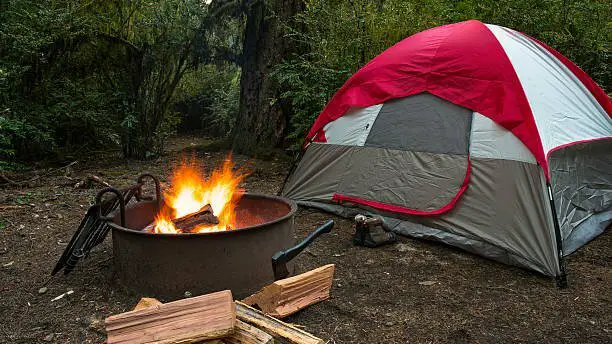
Camping Fire Pit: FAQs
Q. What is the best type of camping fire pit?
There are two primary factors to think about when deciding which fire pit to buy. The first consideration is likely to be monetary in nature. For example, most affordable pits are simple cast-iron ones without sophisticated smoke-free airflow mechanisms.
Consider secondly what you intend to do with your pit. Fires may be built in simple pits to generate heat, light, and sound. You may use them successfully for hot dogs, s’mores, and the occasional hot dog as well. Your cooking options will be more extensive if you invest in a pit that can double as a conventional outdoor barbecue.
Q. Which camping fire pits give off the most heat?
Heat is produced by all fire pits, however some produce more than others. The simplest and least expensive option, ordinary pits, may provide a respectable quantity of heat. Regrettably, they also tend to produce a great deal of smoke. High levels of airflow during combustion allow smokeless fire pits to achieve greater temperatures.
However, in my experience, the majority of the heat generated by Solo Stove fire pits is directed upward. Breeo pits, on the other hand, radiate more heat, making them more comfortable to sit in.
Q. Which smokeless camping fire pit is the best?
Solo Stove fire pits excel in eliminating smoke completely without sacrificing performance. They are the least difficult to light and maintain. They are the cleanest burning and provide the most impressive flames.
But since Solo Stove pits radiate most of their heat upward, they aren’t great for keeping sitting parties warm on chilly winter nights. And you shouldn’t expect to use them to prepare gourmet cuisine in the great outdoors.
Q. Can you put a camping fire pit on grass?
You may install a fire pit on grass, but you need to be careful. Make sure the grassy location you pick is flat, for one thing, or the pit may fall over. Besides, you don’t want to ruin your lawn, so be careful. Heat stress, brought on by the fire pit’s high temperatures, might discolor or destroy your grass. Putting a barrier between the fire pit and the grass is the best approach to keep the grass safe from burns.
You may use patio stones as a base for your fire pit, or you can invest in a heat barrier or a fireproof mat. Regardless of the option you choose, it’s important to avoid damaging vegetation by moving the fire pit around periodically.
Q. Can I cook on my gas fire pit?
With the exception of toasting marshmallows, which only come into contact with the flame and not the pit itself, it is not suggested to cook over a gas fire pit that was not designed for that purpose. However, there are fire pits made specifically for cooking and others that offer safety equipment you may add to your existing fire pit.
